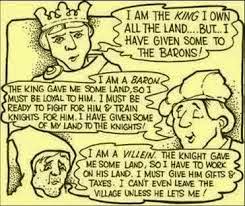We know these terms come from our own history but were the ideals they are based on real?
Not too long ago I sat down to watch The Lion in Winter, one of my all time favourite films. I have two reasons for seeing it as a good film, firstly, because it depicts the medieval period, in this case the court of Henry II, as I believe it was, cold, cruel and barbaric and secondly, the characters portray none of the chivalric behaviour that people of these times thought so very highly of. What we see is an unstable King Henry II, who bellows and bullies his way through the film, whilst his sons are petulant and violent, this is representative of the medieval era and the medieval ruling classes, and how, on the whole, we should see them. There were no glamorous, young and impulsive warriors adorned in shining armour, seeing off fire breathing dragons or saving beautiful damsels, there were only experienced, battle hardened men living in a world of politics, who controlled the country through what has come to be known as feudalism.
Twenty years after conquering our country the king commissioned the Domesday Book where he set out to find what and how much each county had in terms of land and stock, and once it was finished it formed the basic structure of feudalism. The king had no restrictions on his power, he confiscated all the English lands, worked out how very wealthy he was, shared out these lands among his loyal band of followers and expected a declaration of loyalty from everyone in return.
In theory, to him at least, it was a perfect system.
So was it a set of rules laid down or was it just a pattern of behaviour between the weak and the strong?
Were the Normans the first to put this concept into place or did it begin in an earlier, even more barbaric era, a time when life for most was abysmal, where people lived in such terror that they were prepared to pay to be protected or maybe it was the other way round, where weak tribal leaders and later as we've seen with kings, brought support by giving their nobles the opportunity to be land holders themselves.
It is here, among the newly landed medieval knightly class that chivalry was born and chivalric values come into play. The code of chivalry is described in the Song of Roland, a poem based on a battle that took place in the year 778 where it talks of a code of conduct a medieval knight must abide by.
To fear God and maintain his Church
To serve the leige lord in valour and faith
To protect the weak and defenceless
To live by honour and for glory
To fight for the welfare of all
To obey those placed in authority
To guard the honour of fellow knights
To respect the honour of women
Chivalry, in reality is a myth, the idealised image we have in our heads was created for us in the tales of Walter Scott, the poems of Tennyson and the images of Bauer, Waterhouse and Leighton and as far as feudalism goes medieval historians are now arguing that there was no such thing as a feudal system at all and suggest that chivalry was just simple propaganda by the knightly class who needed to be seen as heroes in the face of the poor who complained of bullying and a life of subjugation.





 RSS Feed
RSS Feed
